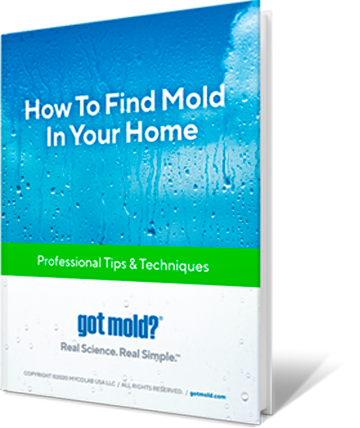
Do you need to be concerned about moisture and mold in your home?
According to the U.S. Department of Housing and Urban Development, moisture is public enemy #1 in your home. Excess humidity levels or water leaks can lead to mold growth, attract pests, increase allergens, cause structural issues through rot and decay, and negatively impact the health of occupants.
Unfortunately, it’s not always easy to see signs of a water leak or humidity issues in your home.
Sure, a flooded basement is obvious.
But not all sources of excess moisture in the home are immediately apparent.
Excess humidity inside your home can be caused by everyday activities such as air-drying laundry, cooking, and showering, to name just a few.
Luckily, your senses can help you identify moisture and mold issues at home. So, when should you worry about moisture or mold? Here are three signs of trouble:
#1. You See Something
Mold
Visible mold is an obvious example of seeing something that’s not quite right.
While people tend to be concerned about toxic black mold (Stachybotrys chartarum), mold actually comes in a range of colors. Mold often tends to start growing as fuzzy, white fibers. As it develops and reaches maturity, mold will start to look gray, green, or black. It usually grows in a circular pattern but can also grow in patches or streaks.
Dark spots of mold are an easy red flag to notice!
But excess humidity and water leaks also leave other visible signs in their wake.
Condensation
Condensation is the change of water from its vapor form into liquid form. It generally happens when water vapor in warm air encounters a cool surface (like a window) or pockets of colder gasses.
When the steam from the shower covers your bathroom mirror or your glasses steam up when you lift the lid of a boiling pasta pot, that’s condensation in action.
In your home, condensation on the interior of windows and doors occurs when warm, humid air comes into contact with a cool surface.
As a result, you’ll see water droplets form on window glass, exterior doors, and even down near the ground level of closets or rooms with exterior walls.
Rot and Decay
Excess humidity or hidden water leaks will flip a switch on the process of rot and decay, essentially “turning on and turning up” the cycle of destruction for your building materials.
Some of the visible signs of rot and decay due to moisture in your home include:
- decay of wood (soft, rotten wood)
- corrosion of metals (rust)
- blistering and peeling paint
- water stains
- discoloration on surfaces
- trim pulling from the wall
Any visible sign of degradation of your home (or its building materials) is another red flag of a moisture issue.
Insects and Pests
Water is life. It makes up the majority of our planet and our bodies. Of course, plants and animals also need it to survive.
Including pests.
When your home has become a source of water, you are likely to notice an increase in the critters in your home, such as:
- dust mites
- water bugs
- insects
- arachnids (spiders)
- wood-eating insects (termites)
- rodents
- and more!
Have you noticed an increase in creepy crawlies, critters, and pests in and around your home?
It may result from a water leak or excess humidity providing lots of wonderful, life-giving water to the tiny creatures that like to share our spaces.
#2. You Smell Something
Does your house smell a little funky?
If your household visitors are always wrinkling their noses and murmuring something about “that basement smell,” or if you feel like your house often reeks of stinky socks, old cheese, or dog farts (hey, you don’t even have a dog!)…don’t ignore it. Your nose knows!
Microbial volatile organic compounds (mVOCs) are strong-smelling compounds produced by fungi (mold) and bacteria during their metabolic processes.
“Because mVOCs often have strong or unpleasant odors, they can be the source of the ‘moldy odor’ or musty smell frequently associated with mold growth,” says the Environmental Protection Agency (EPA).
“A moldy odor suggests that mold is growing in the building and should be investigated.”
The bad news: a musty or moldy odor is a giant red flag that you’ve got mold growing somewhere. Furthermore, it’s more than an aesthetic nuisance. It’s also a health hazard, as you will see below.
The good news: your nose can alert you to the presence of mold even if you can’t visibly see it anywhere.
Why is this good news?
Well, if you smell something, you can do something. You can confirm that you have a mold or moisture problem and take steps to get it fixed.
If you couldn’t see it and couldn’t smell it, the mold growing in some out-of-sight place in your home may be left to run rampant. Undetected mold, after all, is often the most destructive. So thank your nose for doing its job and alerting you that something in your house just isn’t right.
Tip: fix it, don’t cover it! If your house smells funky, musty, or moldy, don’t just cover it up with scented candles, fabric sprays, or plug-in scents. Not only does covering up the smell not fix the problem, but household fragrances can be a source of hundreds of different chemicals—including volatile organic compounds (VOCs)—that can lead to negative health effects ranging from migraines to respiratory issues, immune system problems, cardiovascular issues, and more.
#3. You Feel Something
No, we’re not talking about using The Force, ESP, or another other-worldly sense to determine that something is amiss. (Though you shouldn’t discount the power of intuition when it comes to your health!)
When we say “If you feel something, do something,” we’re talking about feeling respiratory, allergic, or other symptoms in your physical body.
Symptoms of mVOC Exposure
Researchers have discovered that kids living in a home that smells musty have double the risk of developing asthma compared to kids living in homes that are mVOC-free.
According to the EPA, the health effects of inhaling mVOCs are largely unknown, although exposure to mVOCs has been linked to:
- headaches
- nasal irritation
- dizziness
- fatigue
- nausea
- sinusitis
- brain fog
- allergic reactions
- asthmatic episodes
- irritated eyes, throat, and skin
Symptoms of Mold Allergies & Sickness
Everyone breathes in mold spores all day long, from both outdoor and indoor air, mostly without any ill effect. Some people, however, have an allergic reaction similar to asthma symptoms when exposed to high concentrations of mold spores. Others develop sinusitis, an inflammation of the sinuses which can lead to infection. In these cases, the immune system is overly sensitive to mold spores and treats them as an invader, triggering a cascade of allergic symptoms.
According to the American Academy of Allergy Asthma & Immunology (AAAAI), symptoms of a mold allergy can look like:
- sneezing
- runny nose
- nasal congestion
- itchy, watery eyes
- itchy nose, mouth and lips
- asthma symptoms (such as wheezing, shortness of breath or chest tightness)
These symptoms are commonly the result of an immune-system reaction to mold, manifesting similarly to an everyday allergy attack or some sort of respiratory disruption.
However, the second type of mold response is an inflammatory reaction to mold.
An inflammatory response to mold is thought to be driven by mycotoxins, naturally occurring toxins produced by mold, which can initiate an inflammatory cytokine-driven response in the body. Evidence is mounting, though, that the chemicals in the musty odor are a significant variable in the mold and inflammation equation.
According to Parsley Health, this chronic mold-induced inflammation in the body has been linked to a wide variety of ill health effects, including:
- cognitive difficulties (brain fog, poor memory, anxiety)
- pain (especially abdominal pain, but can include muscle pain similar to fibromyalgia)
- unexplained weight gain or weight loss
- numbness and tingling in extremities or other areas of the body
- metallic taste in the mouth
- vertigo or dizziness
- tinnitus (ringing in the ears)
- digestive issues (especially limited tolerance to food, persistent bloating)
- significant fatigue that interferes with daily activities
- changes in mood
- excessive thirst and dehydration, bed-wetting in children
- symptoms that resemble hormone imbalances (hair loss, rashes)
As you may guess from looking at this list, the symptoms of mold-related/mycotoxin-induced illnesses could easily be mistaken for something else. Many things can cause inflammatory responses in the body, not just mold. Inspecting and testing for mold problems in your home can help you and your medical professionals determine if mold is the culprit behind these symptoms.
Do Something!
Did you see a spot of mold, smell a musty odor, or experience a physical symptom related to mold sickness? Then it’s time to do something about it.
As we say here at GOT MOLD?:
“If you see something, smell something, or feel something… do something!”
Mold will not go away on its own. And neither will the physical symptoms that go along with mold allergies or mold toxicity. If you see, smell, or feel something, it’s time to take action. Get a confirmation that you have a mold issue through a mold test kit or inspection, then make a plan to get the moisture and mold problems under control.
To learn more about the dangers of excess moisture in or around your house, or for tips on how to get to the bottom of the issue, read The Complete Guide to Humidity and Moisture in the Home.


If I get my ducks cleaning will this help
Hi Ann – Keeping your ducts clean is always a good idea!